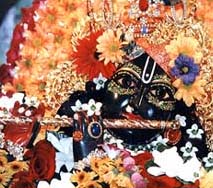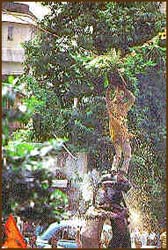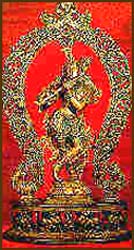|
Festivals of India
Janamashthami
|
|||||
This festival occurs on the eight day (Astami) of a lunar fortnight hence the name (Krishna+asthami). Krishnasthami which is usually in August is celebrated over two days. The first day is Krishnastami or Gokulastami. The second day is called Kalastami or more popularly Janmasthami. In 2016, Sri Krishna Jayanti in North India is 25th August. In 2017, Janamashthami is on 14th August. |
Festivals Of India • Festival Calendar • Ganesh Chaturthi • Nagpanchmi • Ramanavami • Diwali • MahaShivratri • Passage to India • Features • Tips | ||||
At midnight between the first and second days the 'birth of Lord Krishna is replicated with pomp and ceremony. Delicacies are prepared from milk and curds that Krishna loved. The more popular ceremony of Dahi-handi (breaking a pot full of milk and its derivatives} takes place on the second day. This ceremony is so popular that Krishnastami has come to be synonymous with the ceremony of Dahi-handi.
The Ceremony of Dahi-Handi In his childhood, Lord Krishna along with his mates used to raid the houses of his neighbours in search of milk and butter. It is a common practice in India to tie up food articles in a pot suspended from the beams of the roof so as to prevent domestic animals like cats and dogs from despoiling them. We are told that every day after the men and womenfolk left for their farms, the naughty and adventurous Krishna along with a band of his mates would build a human pyramid and plunder the caskets of milk and butter much to the chagrin of the owners. Krishna Lila The story of Lord Krishna reflects life in a pastoral society. Cattle are the principal means of subsistence. The activity of people revolves around tending cows, milking them, making curds, butter etc. Krishna himself has names displaying a pastoral charecter. Govinda and Gopala as he is also known, mean cowherd. In Sanskrit 'go' means cow. Krishna is always shown with his flute (Bansuri). He is considered to be the Hindu God of Music and is the patron god of Indian musicians of the traditional schools (Gharanas), irrespective of their religion. In brief the life story of Krishna according to mythology is as follows: The Cruelty of Kansa Lord Krishna at Gokul At Gokul, under king Nanda's protection, Krishna got the loving affection of Nanda's Queen Yashoda whom Krishna looked upon as a mother. Days passed in fun and frolic, while the child-Krishna grew up. But one day rumours reached Kansa that Devaki's son had somehow escaped his cluthes and was living in Gokul. The Demoness Putana Kalia Mardan and the Lifting of Mt. Govardhan Among other things, he is said to have done at Gokul, he lifted Mount Govardhan to save the people of Gokul from a storm. He also tamed Kalia, a giant snake that lived in the Yamuna river and terrorised the people of Gokul. While still in his teens, Krishna came to Mathura where King Kansa had organised a wrestling tournament. Krishna participated in it and after defeating all the contestants, he challenged Kansa to a wrestling bout. The evil Kansa's time was up: Krishna defeated him and killed him. The people of Mathura were relieved. Another major event in Krishna's later life was that he functioned as an adviser to the Pandavas and during the Mahabharata war between the Pandavas and Kauravas he was Arjuna's (one of the five Pandava brothers) charioteer. The original recitation of the Bhagvad Geeta (Song of the Blessed Lord) is accredited to him. This document contains profound ideas on many issues touching on the temporal and non-temporal aspects of life. |
|||||
Editor: Romola Butalia (c) India Travelogue. All rights reserved. |
|||||
 During this ceremony a large earthenware pot is filled with milk, curds, butter, honey fruits etc. and is suspended from a height between 20 to 40 feet. Sporting young men and boys come forward to claim this prize. To do so they construct a human pyramid by standing over each other's shoulders till the pyramid is tall enough to enable the topmost person to reach the pot and claim the contents after breaking it. Normally, currency notes are tied to the rope by which the pot is suspended. This prize money is distributed among those who participate in the pyramid building
During this ceremony a large earthenware pot is filled with milk, curds, butter, honey fruits etc. and is suspended from a height between 20 to 40 feet. Sporting young men and boys come forward to claim this prize. To do so they construct a human pyramid by standing over each other's shoulders till the pyramid is tall enough to enable the topmost person to reach the pot and claim the contents after breaking it. Normally, currency notes are tied to the rope by which the pot is suspended. This prize money is distributed among those who participate in the pyramid building

 Kansa, the king of Mathura was a very cruel tyrant. His tyranny spared no one, even the sages had to bear the brunt of this. Finally the gods could tolerate no more of it and in a dream Kansa was told that his evil reign would be brought to an end by his sister Devaki's son who would kill him. The cowardly tyrant immediately threw his sister Devaki and her husband Vasudev in prison so that he could kill all the sons born to Devaki.
Kansa, the king of Mathura was a very cruel tyrant. His tyranny spared no one, even the sages had to bear the brunt of this. Finally the gods could tolerate no more of it and in a dream Kansa was told that his evil reign would be brought to an end by his sister Devaki's son who would kill him. The cowardly tyrant immediately threw his sister Devaki and her husband Vasudev in prison so that he could kill all the sons born to Devaki.
 The generous king Nanda gave away his new born daughter to Vasudev knowing fully well what fate awaited her at Kansa's hands. Next morning Kansa completed his gruesome job complacent of the fact that his would-be avenger was still living.
The generous king Nanda gave away his new born daughter to Vasudev knowing fully well what fate awaited her at Kansa's hands. Next morning Kansa completed his gruesome job complacent of the fact that his would-be avenger was still living.